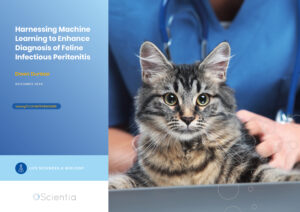Dawn Dunbar | Harnessing Machine Learning to Enhance Diagnosis of Feline Infectious Peritonitis
Feline infectious peritonitis (FIP) is a severe and often fatal viral disease of cats which poses significant diagnostic challenges for veterinarians. Dawn Dunbar from the University of Glasgow is leading a research study with the goal of applying machine learning to revolutionise the diagnosis of FIP. By leveraging routinely collected clinical laboratory data, this innovative approach may pave the way for more accurate and timely diagnoses, ultimately improving outcomes for affected cats and their owners.
The Enigma of Feline Infectious Peritonitis
Feline infectious peritonitis is a complex and devastating disease caused by feline coronavirus (FCoV). While FCoV is prevalent in cat populations, particularly in multi-cat environments, only a small fraction of infected cats develop FIP. The disease is characterised by a severe immune-mediated inflammatory response affecting multiple organs, leading to a wide range of clinical signs that can make diagnosis challenging. The disease may present in an effusive or ‘wet’ form, associated with an accumulation of fluid in the cat’s abdomen or chest, or in a non-effusive or ‘dry’ form, where no fluid build-up is evident.
Confirming a diagnosis of FIP, especially in cases of the non-effusive form, often necessitates invasive procedures such as biopsies and immunohistochemistry, which are typically performed post-mortem. To diagnose FIP in living cats, veterinarians must instead rely on interpreting a combination of clinical signs and laboratory tests using expert consensus guidelines. This intricate decision-making process can be challenging for primary care clinicians who may not have extensive experience with this elusive disease.
The Promise of Machine Learning in FIP Diagnosis
Dawn Dunbar, a researcher at the University of Glasgow, recognised the untapped potential of machine learning (ML) in addressing the challenges of FIP diagnosis. ML, a subset of artificial intelligence, enables computers to learn from data without being explicitly programmed. By training ML algorithms on vast clinical and laboratory information datasets, hidden patterns and associations that might have eluded human observation may emerge.
Ms Dunbar hypothesised that applying ML to routinely collected blood chemistry, haematology and serology data could lead to the development of accurate and reliable models for classifying suspected FIP cases. ‘Our goal was to thoroughly test this hypothesis, without bias towards any specific algorithm or laboratory test’, she explains.
Building the Machine Learning Models
To construct the ML models, Ms Dunbar and her team utilised a dataset comprising nearly 2,000 suspected FIP cases interpreted by expert clinicians using consensus diagnostic guidelines. Each case was classified as either high-suspicion of FIP or no-suspicion of FIP based on a combination of signalment, history, clinical signs and laboratory data.
The researchers then trained and validated two types of ML processes, known as ‘ensemble models’, using this comprehensive dataset. Ensemble models combine the predictions of multiple individual models to enhance overall performance. The first ensemble employed extreme gradient boosting (XGBoost), while the second used a mix of algorithms, including random forests, naive Bayes, logistic regression and support vector machines.

Encouraging Results and Future Directions
The study results were highly promising, with both ensemble models demonstrating remarkable accuracy in successfully classifying FIP and non-FIP cases. When evaluated on a separate dataset of 80 cases with confirmed diagnoses, the models achieved an impressive accuracy of 97.5%, with a sensitivity of 95.45% and a specificity of 98.28%.
‘These results underscore the feasibility and potential of applying machine learning to FIP diagnosis’, notes Ms Dunbar. However, she also acknowledges the study’s limitations, such as the reliance on expert opinion rather than a definitive ‘gold standard’ for the training dataset. Nevertheless, the study provides compelling evidence to support the principle that ML can be effectively applied to FIP diagnosis. Ms Dunbar is optimistic about the future of this approach, stating, ‘While further work is necessary before a deployable ML tool is available, the high level of accuracy achieved by these preliminary models is immensely encouraging’.
One of the primary challenges in developing a generalisable ML tool for FIP diagnosis will be accounting for variations between laboratories in their testing methods and equipment. This could be addressed by either standardising methodologies or developing models that can adapt to data from different sources.
Implications for Veterinary Medicine and Beyond
Ms Dunbar explains ‘This work demonstrates that, in principle, ML can be applied to detect hidden patterns in laboratory test datasets to provide useful, actionable diagnostic information. However, before ML can be deployed in the laboratory as a diagnostic tool for FIP, further work is required, such as training models on datasets of confirmed cases and accounting for inter-laboratory variation.
If these challenges can be overcome, ML may become an invaluable addition to the diagnostic toolkit for veterinarians. By automating complex clinical and laboratory data interpretation, ML models offer to help standardise and accelerate the diagnostic process, leading to earlier and more accurate diagnoses. This could be of particular benefit for diseases such as FIP, where early intervention with antiviral treatments can significantly improve patient outcomes.
Ms Dunbar and her team hope their work lays the foundation for the development of ML-based diagnostic tools that can be seamlessly integrated into veterinary laboratory workflows. Moreover, the principles and techniques employed in this study could potentially be applied to other challenging diseases in veterinary medicine and human healthcare. The ability of ML to uncover cryptic patterns and associations in large-scale clinical laboratory datasets could lead to breakthroughs in the diagnosis, prognosis and treatment of a wide range of intractable diseases and conditions.
In conclusion, this groundbreaking research highlights the immense potential of machine learning to transform the diagnosis of complex diseases such as feline infectious peritonitis. By harnessing the power of routinely collected clinical and laboratory data, ML models could provide veterinarians with a powerful new tool to aid in intricate diagnostic decisions. While further refinement and validation of these models are necessary, the promising results of this study suggest that ML could have a profound impact on veterinary medicine and beyond in the coming years. As Ms Dunbar and her team continue to push the boundaries of what is possible with ML in disease diagnosis, the future looks brighter for countless animals and their human companions.
SHARE
DOWNLOAD E-BOOK
REFERENCE
https://doi.org/10.33548/SCIENTIA1116
MEET THE RESEARCHER

Dawn Dunbar
Veterinary Diagnostic Virology Senior Technician
University of Glasgow, Scotland, UK
Dawn Dunbar obtained her BSc (Hons) in Microbiology from the University of Glasgow in 2005. She is currently a Senior Virology Technician in the Veterinary Diagnostic Service at the University of Glasgow while also pursuing her PhD part-time, which is focused on enhancing feline infectious peritonitis (FIP) diagnosis. Ms Dunbar has extensive experience in molecular diagnostic methods, sequencing, bioinformatics and machine learning. Her research combines her expertise in virology, computational biology and mathematics to develop a deeper understanding of feline coronavirus and FIP. Ms Dunbar is passionate about developing highly accurate, non-invasive methods for the conclusive ante-mortem diagnosis of FIP, which has become increasingly important with the emergence of successful anti-viral treatments. She collaborates with researchers within and outside the University and is actively involved in teaching, mentoring and public engagement.
CONTACT
E: dawn.dunbar@glasgow.ac.uk
W: www.gla.ac.uk/fip
X: @VDS_GlasgowVet
Facebook: @VDSGlasgowVet
KEY COLLABORATORS
Professor Willie Weir and Dr Simon Babayan: School of Biodiversity, One Health and Veterinary Medicine, University of Glasgow, Scotland, UK
Professor Margaret Hosie: MRC-Centre for Virus Research, University of Glasgow, Scotland, UK
FUNDING
Ms Dunbar’s doctoral studies are funded by the School of Biodiversity, One Health and Veterinary Medicine, University of Glasgow, the ‘Luca Fund for FIP Research’ and EndFIP®.
FURTHER READING
D Dunbar, SA Babayan, S Krumrie, et al., Assessing the feasibility of applying machine learning to diagnosing non-effusive feline infectious peritonitis, Scientific Reports, 2024, 14, 2517. DOI: https://doi.org/10.1038/s41598-024-52577-4
D Dunbar, W Kwok, E Graham, et al., Diagnosis of non-effusive feline infectious peritonitis by reverse transcriptase quantitative PCR from mesenteric lymph node fine-needle aspirates, Journal of Feline Medicine and Surgery, 2019, 21(10), 910–921. DOI: https://doi.org/10.1177/1098612X18809165

REPUBLISH OUR ARTICLES
We encourage all formats of sharing and republishing of our articles. Whether you want to host on your website, publication or blog, we welcome this. Find out more
Creative Commons Licence (CC BY 4.0)
This work is licensed under a Creative Commons Attribution 4.0 International License. 
What does this mean?
Share: You can copy and redistribute the material in any medium or format
Adapt: You can change, and build upon the material for any purpose, even commercially.
Credit: You must give appropriate credit, provide a link to the license, and indicate if changes were made.
SUBSCRIBE NOW
Follow Us
MORE ARTICLES YOU MAY LIKE
Professor JoAnne S. Richards | Revealing the Secrets of the Ovary
Professor JoAnne S. Richards conducts her vital research at the Baylor College of Medicine in Houston, Texas, in the USA. For decades she has investigated how certain hormones regulate ovarian function at particular stages of the menstrual cycle, as well as developing new ways to study ovarian cancer. Her work also helps shed new light on common female reproductive health disorders that can affect fertility.
Professor Sung-Hou Kim | New Insights into Ethnic and Genomic Diversity
Does our ethnic diversity translate to genomic diversity? New findings suggest that it might not and point instead to considerable genomic similarities across multiple ethnicities. Professor Sung-Hou Kim at the University of California, Berkeley, and his colleagues classified 164 ethnic groups into 14 genomic clusters spread across various geographical regions. Their findings reveal important new insights into our shared human genetic heritage.
Professor Irene Díaz-Moreno – Professor Miguel A. De la Rosa | The Diverse Interactome of Cytochrome c: Beyond Respiration
All living things are comprised of cells, and to function, most of them use oxygen to break down food molecules to obtain chemical energy, a process known as cell respiration. Critical to this is the macromolecule cytochrome c, but this redox haemoprotein also boasts a diverse set of functions beyond respiration. Professor Irene Díaz-Moreno and Professor Miguel A. De la Rosa, both leading members of cicCartuja’s Biointeractomics Research Group at the University of Seville, are using cutting-edge investigational tools to study the full ‘interactome’ of this multifunctional molecule.
Dr Wolfgang Quapp – Professor Josep Maria Bofill | Shaping Reactions: The Exciting World of Mechanochemistry and Molecular Interactions
Dr Wolfgang Quapp and Professor Dr Josep Maria Bofill from the University of Leipzig and Universitat de Barcelona, respectively, are leading voices in the newly emerged sector of mechanochemistry. Their fascinating work reveals how external forces can manipulate molecular behaviour and influence chemical reactions.





